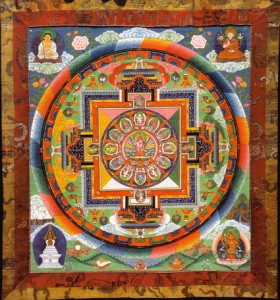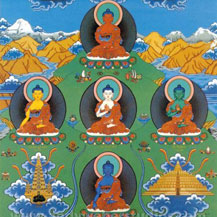Colors used in the Mandala
 Traditionally, a thangka painting (Tibetan Buddhist scroll painting) is very colorful as you can see on the Amitayus mandala on the right.
Traditionally, a thangka painting (Tibetan Buddhist scroll painting) is very colorful as you can see on the Amitayus mandala on the right.
The colors draw your attention so can’t help but looking at it, and that’s exactly the goal, as a thangka wants to communicate something to the person looking at it. The mandala stands for ideal ‘universe of the self’, the highest level of consciousness, the enlightened state of mind.
The colors that are used in a traditional Tibetan Buddhist mandala blue, green, red, yellow and white.
These five colors come from nature and each has a deep meaning.
Mandala of Amitayus, one of the Buddhas of Longevity. Amitayus is connected to the red Buddha Amitabha
The Five Buddha families
 The colors that are used in the mandala correspond with the 5 Buddhas and their families, as well as the 4 wind directions (the 5th is the center).
The colors that are used in the mandala correspond with the 5 Buddhas and their families, as well as the 4 wind directions (the 5th is the center).
There are many methods for developing our mind to higher levels of consciousness. One of the most profound is that of the ‘Five Buddha Families’: an old Buddhist system in order to understand the mind and its different aspects; and to work with that. This Five Buddha Family principle is Central to Tibetan Vajrayana Buddhism.
Diagram of the Five Buddhas, thangka painting by Andy Weber
Each of the Buddha families embodies one of the five different aspects of enlightenment. However, these aspects not only manifest themselves as enlightened energies, but also as the neurotic states of our mind; such as pride or arrogance, anger, jealousy, attachment, and ignorance. The Buddha families therefore show us a complete picture of both the neurotic world of an on ego based existence as well as the purified, enlightened State of mind. What makes the difference is the path of awakening.
The names of the 5 Buddhas, their colors and their families
- Vairochana
White Buddha (sometimes blue), head of the Buddha family - Akshobhya
Blue Buddha (sometimes white), head of the Vajra family - Ratnasambhaba
Yellow Buddha, head of the Ratna or jewel family - Amitabha
Red Buddha, head of the Padma or lotus family - Amoghasiddhi
Green Buddha, head of the Karma or action family



